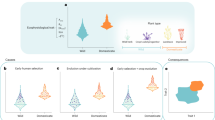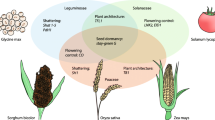Abstract
Despite current recognition as the largest family of flowering plants (23,000 species ± 1000; Anderberg et al. 2007), the Compositae is home to comparatively few important crop species. To assess domestication levels in the Compositae, we developed an index that categorizes taxa according to the strength of domestication. Most Compositae species that are used by humans exhibit little or no evidence of domestication and only a handful have been strongly domesticated. Although the Compositae (along with Orchidaceae) has few domesticated taxa compared to other large families such as Fabaceae or Poaceae, Compositae species have features that should make them suitable for domestication and human consumption. These include high species diversity, global geographic distribution, good seed storability, and good seed oil quality. We propose that the paucity of domesticated species in this family can be attributed to a variety of factors, chiefly the prevalence of secondary defence compounds, the lack of carbohydrates that can be digested by the human gut and the predominantly mechanical or wind-dependent seed dispersal syndrome. We also discuss the relevance of genetic and cultural factors. Although few Compositae crops currently play a major role in global agriculture, many species hold unexploited potential, especially as novel crops for food and industrial applications.



Similar content being viewed by others
References
Abbo S, Gopher A, Rubin B et al (2005) On the origin of Near Eastern founder crops and the “dump-heap hypothesis”. Genet Resour Crop Evol 52(5):491–495
Anderberg AA, Baldwin BG, Bayer RG et al (2007) Compositae. In: Kubitzki K (ed) The families and genera of vascular plants. VIII. Flowering plants, eudicots, asterales (eds. Kadereit JW, Jeffrey C). Springer, Berlin-Heidelberg-New York, pp 61–588
Basciano HL, Federico L, Adeli K (2005) Fructose, insulin resistance, and metabolic dyslipidemia. Nutr Metab 2(5):1–14
Bellwood PS (2005) The first farmers: the origins of agricultural societies. Blackwell, Malden
Bohm BA, Stuessy TF (2001) Flavonoids of the sunflower family (Compositae). Springer, Vienna
Burke JM, Tang S, Knapp S et al (2002) Genetic analysis of sunflower domestication. Genetics 161(3):1257–1267
de Kraker JW, Franssen MCR, de Groot A et al (1998) (+)––Germacrene a biosynthesis––the committed step in the biosynthesis of bitter sesquiterpene lactones in chicory. Plant Physiol 117(4):1381–1392
deVries IM (1997) Origin and domestication of Lactuca sativa L. Genet Resour Crop Evol 44(2):165–174
de Wet JMJ (1992) The three phases of cereal domestication. In: Chapman GP (ed) Grass evolution and domestication. Cambridge University Press, Cambridge, pp 176–198
Diamond JM (1997a) Guns, germs, and steel: the fates of human societies. W.W. Norton & Co, New York
Diamond JM (1997b) Location, location, location: the first farmers. Science 278(5341):1243–1244
Diamond JM (2002) Evolution, consequences and future of plant and animal domestication. Nature 418(6898):700–707
Doebley JF, Gaut BS, Smith BD (2006) The molecular genetics of crop domestication. Cell 127(7):1309–1321
Elliott SS, Keim NL, Stern JS et al (2002) Fructose, weight gain, and the insulin resistance syndrome. Am J Clin Nutr 76(5):911–922
Fields M (1998) Nutritional factors adversely influencing the glucose/insulin system. J Am Coll Nutr 17(4):317–321
Funk VA, Bayer R, Keeley S et al (2005) Everywhere but Antarctica: using a supertree to understand the diversity and distribution of the Compositae. In: Friis I, Balslev H (eds) Proceedings of a symposium on plant diversity and complexity patterns – local, regional and global dimensions, Copenhagen, 2005
Gepts P (2004) Crop domestication as a long-term selection experiment. Plant Breed Rev 24(Part 2):1–44
Gomes A, Saha A, Chatterjee I (2007) Viper and cobra venom neutralization by β-sitosterol and stigmasterol isolated from the root extract of Pluchea indica Less. (Asteraceae). Phytomedicine 14(9):637–643
Hancock JF (2004) Plant evolution and the origin of crop species. CABI, New York
Harlan JR (1986) Lettuce and the sycamore – sex and romance in Ancient-Egypt. Econ Bot 40(1):4–15
Harlan JR (1992) Origins and processes of domestication. In: Chapman G (ed) Grass evolution and domestication. Cambridge University Press, Cambridge, pp 159–175
Harlan JR (1995) The living fields. Cambridge University Press, New York
Heiser CB (1969) Systematics and the origin of cultivated plants. Taxon 18(1):36–45
Heiser CB (1988) Aspects of unconscious selection and the evolution of domesticated plants. Euphytica 37(1):77–81
Heywood VH, Harborne JB, Turner BL (1977) The biology and chemistry of the Compositae. Academic Press, New York
Jeffrey C (2001) Compositae. In: Hanelt P, Institute of Plant Genetics and Crop Plant Research (eds) Mansfeld´s encyclopedia of agricultural and horticultural crops, vol 4. Springer, Berlin-Heidelberg-New York, pp 2035–2145
Judd WS (2002) Plant systematics: a phylogenetic approach. Sinauer Associates, London
Kane N, Rieseberg LH (2007) Genetics and evolution of weedy Helianthus annuus populations: evidence of multiple origins of an agricultural weed. Mol Ecol 17(1):384–394
Keimer L (1924) Die Gartenpflanzen im alten Aegypten. Hoffmann und Campe, Hamburg
Kesseli RV, Michelmore RW (1997) The Compositae: systematically fascinating but specifically neglected. In: Paterson AH (ed) Genome mapping in plants. RG Landes, Georgetown, pp 179–191
Kislev ME, Baryosef O (1988) The legumes – the earliest domesticated plants in the near-East. Curr Anthropol 29(1):175–179
Lachenmeier DW, Walch SG, Padosch SA (2006) Absinthe – a review. Crit Rev Food Sci 46(5):365–377
Ladizinsky G (1998) Plant evolution under domestication. Kluwer Academic Publishers, London
Lorenzo CM, Marco M, Paola DM et al (2006) Long distance transport of ragweed pollen as a potential cause of allergy in central Italy. Ann Allergy Asthma Immunol 96(1):86–91
Mansfeld Database based on Hanelt P and Institute of Plant Genetics and Crop Plant Research (eds) (2001) Mansfeld’s encyclopedia of agricultural and horticultural crops, vols 1–6. Springer, Berlin-Heidelberg-New York, 3716 pp
Naumann CT, Hartmann T, Ober D (2002) Evolutionary recruitment of a flavin-dependent monooxygenase for the detoxification of host plant-acquired pyrrolizidine alkaloid-defended arctiid alkaloids in the moth Tyria jacobaeae. Proc Natl Acad Sci USA 99(9):6085–6090
Niness KR (1999) Inulin and oligofructose: what are they? J Nutr 129(7):1402S–1406S
Nugent AP (2005) Health properties of resistant starch. Nutr Bull 30(1):27–54
Paulsen E (2002) Contact sensitization from Compositae-containing herbal remedies and cosmetics. Contact Derm 47(4):189–198
Peacock SL (1998) Putting down roots: the emergence of wild plant food production on the Canadian Plateau. Dissertation, University of Victoria
Qinghoasu Antimalarial Co-ordinating Research Group (1979) Antimalarial studies on Qinghaosu. Chin Med J-Peking 92(12):57–58
Rick C (1988) Evolution of mating systems in cultivated plants. In: Gottlieb L, Jain S (eds) Plant evolutionary biology. Chapman and Hall, London, pp 133–147
Roberfroid MB (2002) Functional foods: concepts and application to inulin and oligofructose. Br J Nutr 87(5):139–143
Roberfroid MB (2006) Introducing inulin-type fructans. Br J Nutr 93:S13–S25
Rossell JB (1994) Measurement of rancidity. In: Allen JC, Hamilton RJ (eds) Rancidity in foods. Aspen Publishers, New York, pp 22–53
Sauer JD (1993) Historical geography of crop plants. CRC Press, Boca Raton
Seto MT, Miyase T, Umehara K et al (1988) Sesquiterpene lactones from Cichorium endivia L. and C. intybus L. and cytotoxic activity. Chem Pharm Bull 36:2423–2429
Simpson BB, Ogorzaly M (2001) Economic botany. McGraw-Hill, Boca Raton
Smartt JNW (1997) The domestication syndrome and the development of new crop plants. In: Smartt JNW, Haq N (eds) Domestication, production and utilization of new crops. International Centre for Underutilised Crops (ICUC), Southampton, pp 134–146
Smartt JNW, Simmonds NW (eds) (1995) Evolution of crop plants. Wiley, New York
Smith BD (ed) (1992) The economic potential of Iva annua in Eastern North America. In: Rivers of change: essays on early agriculture in Eastern North America. Smithsonian Institution Press, Washington, DC, pp 185–200
Stevens PF (2007) Angiosperm phylogeny Website, Version 7, May 2006. Missouri Botanical Garden, St Louis, Missouri. Available from: http://www.mobot.org/MOBOT/research/APweb/welcome.html (accessed March 2007)
Survey of Economic Plants for Arid and Semi-Arid Lands (SEPASAL) database (1999) Royal Botanic Gardens Kew, London, United Kingdom. Available from: http://www.kew.org/ceb/sepasal/ (accessed March 2007)
Taylor S, Berridge V (2006) Medicinal plants and malaria: an historical case study of research at the London school of hygiene and tropical medicine in the twentieth century. Trans R Soc Trop Med Hyg 100(8):707–714
Thormann I, Metz T, Engels JMM (2004) The species compendium, Release 1.0, December 2004. Biodiversity International, Rome, Italy. Available from: http://www.bioversityinternational.org/Information_Sources/Species_Databases/Species_Compendium (accessed March 2007)
USDA National Genetic Resources Program (2007) Germplasm resources information network––(GRIN). National Germplasm Resources Laboratory, Beltsville, Maryland. Available from: http://www.ars-grin.gov/ (accessed March 2007)
Venable DL, Levin DA (1983) Morphological dispersal structures in relation to growth habit in the Compositae. Plant Syst Evol 143(1):1–16
Wopfner NG, Gadermaier G, Egger M et al (2005) The spectrum of allergens in ragweed and mugwort pollen. Int Arch Allergy Immunol 138(4):337–346
Yamazaki H, Matsumoto K (1993) Inulin and inulin-bearing crops. In: Fuchs A (ed) Production of fructo-oligosaccharide-rich fructose syrup. Elsevier, Amsterdam, pp 355–358
Zeder MA, Emshwiller E, Smith BD (2006) Documenting domestication: the intersection of genetics and archaeology. Trends Genet 22(3):139–155
Zohary D (1999) Monophyletic vs. polyphyletic origin of the crops on which agriculture was founded in the near East. Genet Resour Crop Evol 46(2):133–142
Zohary D (2004) Unconscious selection and the evolution of domesticated plants. Econ Bot 58(1):5–10
Acknowledgements
We would like to thank Nancy Turner and Stu Crawford for helpful discussions on inulin containing crops; Nolan Kane, Michael Barker, Anne Bjorkman, Catherine D’Andrea and Eric Baack on suggestions for revisions and inspirational conversations; Jeannette Whitton for sharing her experiences in working with Compositae species for so many years; Mark Nesbitt for useful discussions; Ljerka Kunst for insights into oil chemistry; Kathrin Dieterle for sharing with us her views on the role of inulin for human metabolism; two anonymous reviewers for helpful comments on the manuscript; and Scott Black for assisting us with generating the Figures. Funding for studies of Compositae crop and weed evolution has been provided by a National Science Foundation (DBI0421630) and NSERC Discovery grants to QC and LHR, as well as a CIDA grant to LHR, J. Engels, and H. Dempewolf.
Author information
Authors and Affiliations
Corresponding author
Appendix
Appendix
Rights and permissions
About this article
Cite this article
Dempewolf, H., Rieseberg, L.H. & Cronk, Q.C. Crop domestication in the Compositae: a family-wide trait assessment. Genet Resour Crop Evol 55, 1141–1157 (2008). https://doi.org/10.1007/s10722-008-9315-0
Received:
Accepted:
Published:
Issue Date:
DOI: https://doi.org/10.1007/s10722-008-9315-0




